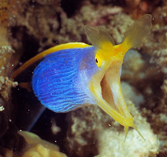| Family: |
Muraenidae (Moray eels), subfamily: Muraeninae |
| Max. size: |
130 cm TL (male/unsexed) |
| Environment: |
reef-associated; marine; depth range 1 - 67 m, non-migratory |
| Distribution: |
Indo-Pacific: East Africa to the Tuamoto Islands, north to southern Japan, south to New Caledonia and French Polynesia; including Marianas and Marshalls. |
| Diagnosis: |
Dorsal spines (total): 0-0; Anal spines: 0-0; Vertebrae: 270-286. Has three fleshy tentacles on the tip of its lower jaw, a single fleshy pointed projection at the tip of its snout, and tubular anterior nostrils ending in gaudy, fanlike expansions.
Description: Characterized by bright blue color with yellow dorsal fin and anterior part of head in male; yellow with black anal fin in female; black with yellow anal fin and white fin margins in juvenile and subadults; capable of male to female sex change; laterally compressed and extremely long body; depth at gill opening 65-75 in TL; origin of dorsal fin well foreward to gill opening, closer to corner of mouth; tail is longer than head and trunk; preanal length 3.0-3.3 in TL; large tubular anterior nostrils with greatly enlarged distal margin, forming fan-shaped appendage; front of upper jaw with forward-projecting slender barbel; three barbels at front of lower jaw; single row of small and slender jaw teeth that is slanted backwards (Ref. 90102). |
| Biology: |
Adults occur in lagoon and seaward reefs. They are secretive species normally hidden in sand or rubble, sometimes with only its head protruding. Feed on small fishes (Ref. 9710, 48635, 75154, 89972). Juveniles all black, males have yellow dorsal fin and females change to a nearly all yellow color, but usually with blue in the posterior (Ref. 48635). Only moray that undergoes abrupt changes in coloration and sex: it is a protandrous hermaphrodite, i.e., functioning males reverse sex to become females. Protandry is diagnosed based on colouration, but not confirmed (Ref. 103751). |
| IUCN Red List Status: |
Least Concern (LC); Date assessed: 04 February 2009 Ref. (130435)
|
| Threat to humans: |
harmless |
Source and more info: www.fishbase.org. For personal, classroom, and other internal use only. Not for publication.
